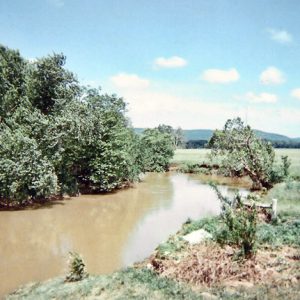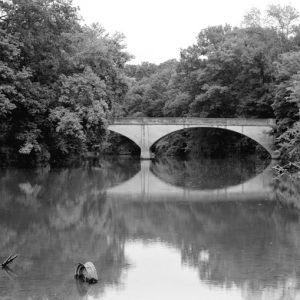calsfoundation@cals.org
Illinois River
Flowing through the Ozark borderlands of eastern Oklahoma and western Arkansas, the Illinois River is fed by 1,660 square miles of drainage area and serves as the primary tributary for the largest lake in eastern Oklahoma, Tenkiller Ferry Reservoir. The Illinois has historically represented an area of significant economic importance and ecological convergence between the hilly Ozarks and the southern plains. The watershed of the Illinois River comprises five counties in Oklahoma and Arkansas, providing more than 100 miles of recreational opportunities. The Illinois River system consists of the Illinois and its tributaries, Flint and Baron Fork creeks, both of which are major tourist destinations for the south-central United States and provide a substantial portion of tourism income for the area.
The earliest historical accounts of the Illinois River basin come from the ill-fated Arkansas River expedition of Thomas Nuttall. After leaving Fort Smith (Sebastian County), Nuttall and company went 130 miles farther up the Arkansas River near the mouth of the Verdigris and Neosho rivers and camped along the banks of the Illinois River. Aside from the geologic description Nuttall provided in his journal, the naturalist mentions salt deposits in the Illinois River and adjacent streams, stating, “A few miles from its mouth, its banks present salt springs similar to those of Grand River, and scarcely less productive; most of the streams on this side of the Arkansa(s) are said to afford springs of salt water which might be wrought with profit.” Nuttall also described hunting buffalo in prairies near the Illinois River. Three days after leaving Belle Point, Nuttall and Bradford reached the confluence of the Illinois and Arkansas rivers, near the site of present-day Tenkiller Reservoir. Nuttall described the river, writing, “The current of the Arkansa(s) was here unusually rapid; on the right hand side the water was clear, but on the left, red and muddy. The clear water issued from the Illinois River, to which we were now contiguous.”
Following forced removal and travails along the Trail of Tears, Native Americans settled in the Illinois River basin some seventy years prior to the infamous Oklahoma “land runs” that would establish white settlements. From 1820 to 1865, agricultural activities in the Cherokee Nation and Illinois basin included small herd cattle raising, spotty cotton farming, and the cultivation of corn as the major grain/subsistence crop. After the economic, political, and social systems in the Cherokee Nation and in Arkansas as a whole were destroyed during the Civil War, the Reconstruction period witnessed increasing white settlement that undermined both Native American sovereignty and stewardship of the natural environment of the Illinois basin from 1865 through the early twentieth century. The increased development of infrastructure systems like cattle trails, railroads, and market roads had a profound effect on the Illinois watershed region.
Throughout the twentieth century, mixed agriculture and watershed recreation represented the two primary modes of land use within the Illinois River basin. In the downstream Oklahoma basin, the importance of nursery farming and small-acreage livestock production within the basin cannot be understated, nor can the approximately $930 million of tourist spending that occurs annually from April to October within the watershed. The Oklahoma Legislature declared the Illinois River in Oklahoma a State Scenic River in 1970. In the upstream Arkansas side of the Illinois River basin, industrialized poultry production from the mid-twentieth century forward substantially increased pollution in the Illinois River. Runoff of poultry waste and pollution from wastewater treatment facilities in booming northwest Arkansas combined to create a near-disaster on the Illinois prior to legislation passed in 2006 promoting water quality standards at the Arkansas-Oklahoma state line.
Forty-five percent of the square mileage of the Illinois River watershed is located within western Arkansas. The river and its tributaries flow first in a northwesterly, then southwesterly path through two Arkansas counties, Benton and Washington. Although poultry production is a significant factor in local economies, Benton and Washington counties are largely suburbanized and driven by white-collar and service industries. The combined population of both Arkansas counties in the watershed was approximately 350,000 by2010, while only 60,000 or so citizens resided in the eastern Oklahoma basin counties of Cherokee, Delaware, and Adair.
From 1977 through 1993, heated debate took place between delegates of Arkansas and Oklahoma regarding river policy and pollution problems. Oklahoma factions sought to place blame on Arkansas poultry producers and other urbanized industries across the border for the poor water quality of the Illinois. The Wild and Scenic Rivers Act of 1993 sought in part to mediate concerns of pollution and water quality on both sides of the Oklahoma-Arkansas border, but in August 2005, Oklahoma attorney general Drew Edmondson levied a $30 million lawsuit on behalf of the state of Oklahoma against the sixteen poultry production companies headquartered in northwestern Arkansas. In 2018, as litigation was ongoing, Arkansas and Oklahoma signed an agreement committing the concerned government agencies in each state to collaborate on developing a watershed improvement plan, as well as sharing data. On January 18, 2023, the U.S. District Court in Tulsa finally ruled on the original 2005 lawsuit, deciding in favor of Oklahoma against Arkansas poultry producers. Rather than pronouncing a settlement, Judge Gregory K. Frizzell urged the parties pursue mediation efforts, but these had failed by October 2023. On June 17, 2025, in response to a request to reconsider his ruling, Frizzell ruled that the river continued to suffer from excessive levels of phosphorus and that Arkansas-based poultry operations bore the primary responsibility for this.
Erosion remains a persistent problem on the Illinois, with a September 2021 report on the subject estimating that some twenty acres of northwestern Arkansas (102,822 tons of sediment) eroded into the river every year.
For additional information:
Agnew, Brad. “Illinois River.” Encyclopedia of Oklahoma History and Culture. https://www.okhistory.org/publications/enc/entry?entry=IL002 (accessed October 31, 2023).
Ballenger, T. A. “The Illinois River.” Chronicles of Oklahoma 46 (Summer 1968): 450–459.
Flores, Dan. “Place: An Argument for Bioregional History.” Environmental History Review 18 (Winter 1994): 1–18.
Grantz, Erin M., and Brian E. Haggard. “Constituent Loads and Trends in Upper Illinois River Watershed: A Nonpoint Source Management Program Priority Watershed.” Arkansas Water Resources Center, Publication MSC 394. February 2023. Online at https://scholarworks.uark.edu/awrctr/369/ (accessed March 20, 2023).
Krause, Robert. An Environmental History of the Illinois River: Agriculture, Urban Development, and Recreation in Northwest Arkansas and Northeastern Oklahoma, 1818–2005. Saarbrücken, Germany: VDM Verlag, 2008.
Smith, Kenneth L. The Illinois River: A People River. Little Rock: Ozark Society Foundation, 1993.
Thompson, Doug. “EPA Eyes Illinois River’s Pollution.” Arkansas Democrat-Gazette, August 4, 2024, pp. 1B, 6B. Online at https://www.arkansasonline.com/news/2024/aug/04/epa-seeks-to-add-illinois-river-portions-to/ (accessed August 5, 2024).
———. “Erosion Concerns Raised at Meeting.” Arkansas Democrat-Gazette, October 17, 2022, pp. 1B, 6B. Online at https://www.arkansasonline.com/news/2022/oct/16/nwa-losing-20-acres-a-year-to-erosion-in-the/ (accessed October 17, 2022).
———. “Mediation Said Failed in Poultry Waste Case.” Arkansas Democrat-Gazette, October 31, 2023, pp. 1A, 5A. Online at https://www.arkansasonline.com/news/2023/oct/30/mediation-efforts-between-oklahoma-and-poultry/ (accessed October 31, 2023).
———. “Poultry Firms Lose Pollution Lawsuit.” Arkansas Democrat-Gazette, January 20, 2023, pp. 1A, 8A. Online at https://www.arkansasonline.com/news/2023/jan/20/arkansas-poultry-companies-pollute-illinois-river/ (accessed January 20, 2023).
Walkenhorst, Emily. “$1.4M Earmarked for Illinois River.” Arkansas Democrat-Gazette, September 17, 2018, pp. 1B, 6B.
Robert Krause
Florida Department of State, Division of Historical Resources
 Illinois River
Illinois River  Illinois River Bridge
Illinois River Bridge 



Comments
No comments on this entry yet.